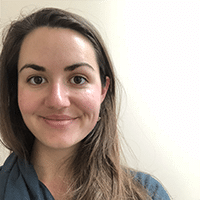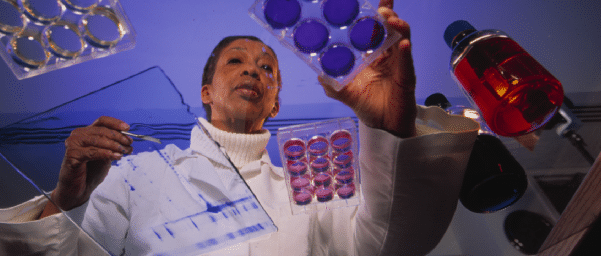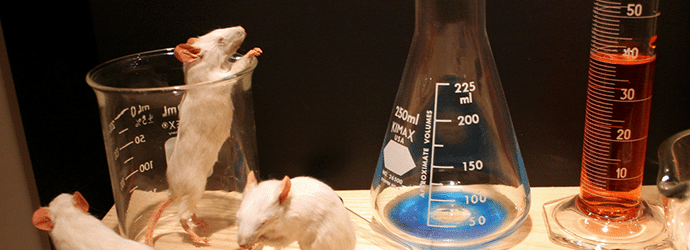The cells I work with are special — they’re stem cells. This means that when it comes to deciding their ultimate fate, they’re still sitting on the fence. This ability is great for identifying pathways of cellular development and differentiation. It also serves research into tissue regeneration and human disease. But how can we make cells with this superpower stand out from the crowd?
Cell Fate 101
As well as being multipotent, stem cells are special because they can produce two different cells when they divide: an exact copy of themselves, which retains stem cell potential, plus a cell that’s more specialized and can go on to differentiate. We call these divisions “asymmetric,” and they make up the majority of stem cell divisions. Terminally differentiated cells that undergo cell division, such as during proliferative tissue growth, usually divide symmetrically.
Once a cell starts down the path to specialization, its options become more and more limited at each step. Eventually, a cell makes its final decision and becomes differentiated or ‘fixed’ as a specialized mature cell. Differentiation is usually a one-way street — once a cell’s identity is determined, there’s no going back. Unless, of course, you induce cells to re-gain their “stem-ness”, but more on that later.
Naturally Occurring Stem Cells
- Embryonic stem cells (ESCs): All cells in the body can be traced back to an original population of ESCs. We call these cells totipotent as they have the unique capacity to become any other cell type.
- Adult stem cells: These are tissue-specific and retain regenerative potential in the fully developed organism. Examples include bone marrow, intestinal epithelial cells, and spermatogonial stem cells. Adult stem cells are typically multipotent (i.e,. capable of differentiating into only a limited number of specific cell types) and are thus much more specialized than ESCs. Regenerative potential into adulthood means these cells have many therapeutic uses, including generation of organoids (mini model organs or tissues derived entirely from stem cells) for modelling human disease progression and treatment.
- Primordial germ cells (PGCs) are the undifferentiated precursors to adult germ cells. While these cells are unipotent (i.e., can only become one cell type, in this case sperm or eggs), they warrant inclusion as they can de-differentiate to pluripotent embryonic germ cells (see below) by culturing with particular extracellular factors (1,2).
Experimentally- or Pathologically-Derived Stem Cells
- Embryonic germ cells (EGCs) are stem cells generated by reprogramming of PGCs. EGCs are thus different to ESCs, which are obtained directly from the inner cell mass of a developing embryo (3). Similar to ESCs, EGCs can also give rise to almost every cell type, although not the placenta. We call this type of cell pluripotent.
- Induced pluripotent stem cells (iPSCs) are virtually indistinguishable from ESCs. Yet, unlike ESCs, iPSCs are generated by reprogramming differentiated cells, like skin or blood cells, back to their embryonic state. This is achieved by introducing genes needed to maintain essential ESC characteristics (4). This process is so remarkable that it earned its co-inventors John Gurdon and Shinya Yamanaka the 2012 Nobel Prize for Physiology or Medicine. iPSCs have extraordinary potential for regenerative medicine as they provide a source of any cell type needed for therapeutic applications. You can, for example, study neurological conditions by turning a patient’s skin cells into iPSCs and then into neurons.
- Cancer stem cells (CSCs): Tumors are maintained by their stem cells. Most cells in a cancer have little proliferative potential, as tumor growth is driven by a small population of CSCs that exist within a cancer (5). CSCs are multipotent or pluripotent progenitor cells that arose from an oncogenic mutation, either in an adult stem cell or even in a differentiated cell (5).
Markers of Pluripotency
Pluripotency is relatively rare and involves specialised gene expression. By staining with specific markers of pluripotency, you can separate ESCs, EGCs, iPSCs, and even PGCs from the differentiated cells that make up the vast majority of tissues.
Enjoying this article? Get hard-won lab wisdom like this delivered to your inbox 3x a week.

Join over 65,000 fellow researchers saving time, reducing stress, and seeing their experiments succeed. Unsubscribe anytime.
Next issue goes out tomorrow; don’t miss it.
When choosing a marker, consider the type of stem cell you are working with and the ultimate application for the cells. Bear in mind that not all markers work for all cell types, and some may bind non-specifically. Some markers are also better suited to certain applications (e.g,. FACS, as explained below), or mark pluripotent cells at different stages of specialization. It really pays to understand their differences and the characteristics of your cell type before you get started. Here are some examples:
- OCT4 (Pou5f): a master regulator of pluripotency useful for ESCs, cancer cells, PGCs, and EGCs6,7. OCT4 marks ‘early’ pluripotency in germ cells, as staining is lost relatively early along the path to specialization (i.e., before meiosis8). Other ‘early’ markers include cKIT (early germ cells and most stem cells)8, and NANOG6.
- DDX4 (VASA): widely used and highly conserved in germ cells — from sponges to flatworms to mammals9. This means there’s a good chance it’ll work with your non-model species. In primordial germ cells, VASA is commonly used alongside OCT4 as it’s a more ‘mature’ marker of cell fate (i.e. persists after meiosis8).
- SSEA-1 (CD15): SSEA-1 staining is characteristic of pluripotent stem cells, particularly PGCs and EGCs6,8. SSEA-1 is also a good general marker as it’s neither ‘early’ nor ‘late’- it spans a good portion of pluripotency. Note that SSEA-1 can sometimes show up in somatic cells if they’ve originated from germ cells, particularly developing neural tissue. SSEA-1 is often used in conjunction with alkaline phosphatase — another useful, yet non-specific, marker- to double-check cell identity.
Useful Applications
While all of these are decent markers of pluripotency in their own right, their real strength lies in the analysis of their colocalization. Multi-colour fluorescent staining is an excellent way to show how far along your cells are on the way to specialization, depending on the combination of markers they express.
SSEA-1 is also particularly useful in isolating pluripotent cells using techniques like fluorescence-activated cell sorting (FACS) and magnetic cell sorting (MACS)8. You can also use pluripotency markers to isolate cells from whole tissue sections (e.g., with laser microdissection). It may also be helpful to counterstain sections with a nuclear stain (like DAPI) so you can see and avoid non-target cells. Cells isolated by either technique can then be fed directly into your lab pipeline of choice.
With a bit of thoughtful preparation, working with stem cells can be very rewarding. After all, these cells have loads of potential. If you want to know more about stem cells, check out the resources below, as well as this article.
Helpful References
- Matsui Y et al. (2014) The majority of early primordial germ cells acquire pluripotency by AKT activation. Development 141:4457-4467.
- Oliveros-Etter M et al (2015) PGC reversion to pluripotency involves erasure of DNA methylation from imprinting control centers followed by locus-specific re-methylation. Stem Cell Reports 5:337-349.
- Kerr CL et al (2006) Embryonic germ cells: when germ cells become stem cells. Semin Reprod Med 24(5):304-313.
- Takahashi K and Yamanaka S (2013) Induced pluripotent stem cells in medicine and biology. Development 140:2457-2461.
- Clevers H (2011) The cancer stem cell: premises, promises and challenges. Nat Med 17:313-319.
- Saitou M and Yamaji M (2012) Primordial germ cells in mice. Cold Spring Harb Perspect Biol 4:a008375.
- Nikolic A et al. (2016) Primordial germ cells: current knowledge and perspectives. Stem Cells Int
- Kerr CL et al. (2008) Expression of pluripotent stem cell markers in the human fetal ovary. Hum Reprod 23(3):589-599.
- Hickford DE et al. (2011) DDX4 (VASA) is conserved in germ cell development in marsupials and monotremes. Biol Reprod 85:733-743.
You made it to the end—nice work! If you’re the kind of scientist who likes figuring things out without wasting half a day on trial and error, you’ll love our newsletter. Get 3 quick reads a week, packed with hard-won lab wisdom. Join FREE here.








